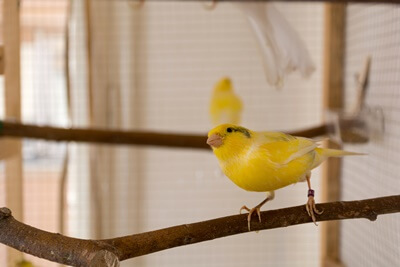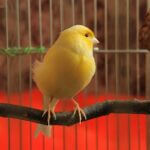Canaries aren’t the most playful birds and don’t require complex toys to stay entertained. However, that doesn’t mean their enrichment needs can be ignored.
Canaries can be entertained with lattice balls, pinecones, bells, perches, swings, and ladders. You can also play music, sing together, dance, provide interesting food, and spend time near it. If you safeguard the room, allowing the canary out to explore and forage for treats will brighten its day.
Remember, canaries like their personal space and rarely learn tricks. Instead of focusing on these bonding exercises, give it all the tools, space, and food it needs to entertain itself.
Do Canaries Get Bored?
Canaries aren’t social animals, so they don’t need the company of another canary to remain happy. While they rarely become lonely, this doesn’t mean they won’t grow bored.
According to Biology Sciences, canaries aren’t as intelligent as parrots or corvids but possess cognitive skills, as evidenced by their complex songs.
According to Behavioral Neurobiology of Birdsong, these require neural pathways that are, in many ways, different from the neurological structures of other avians and mammals alike.
Canaries are smart enough to add complexity, rhythm, syllables, and personal flare to their songs. This skill requires intelligence; if a creature is smart, it’s accepted that it can get bored.
Even without scientific evidence, bored canaries will show the following behaviors:
- Pace
- Repetitive behaviors, like tapping their beak
- Feather-pluck
- Destroy toys or bedding
- Scream rather than sing
- Refusing to sing
- Lose appetite
- Become lethargic
Fortunately, there are many ways to avoid these problems.
What Do Canaries Like To Play With?
Canaries play in simple ways, so they don’t require puzzles, mazes, or other tools that can be used in complex games.
Instead, canaries like to move and hop around, using perches, branches, and swings. They also prefer toys that engage their beaks, like rope and strips of cloth for pecking and tearing.
Do Canaries Like Toys?
Canaries enjoy toys, but they don’t require too many. Also, the toys don’t need to be complex, so about three toys in a cage will suffice.
Canaries tire of the same old toys, so you need a few extras to swap out every few months.
Do Canaries Like Music?
Canaries enjoy music and will feel enriched when exposed to high-pitched but soft melodic songs. Classical music is a favorite for pet canaries, especially anything with violins, flutes, and keyboards.
Canaries enjoy listening to music more than most pets. According to The The Journal of the Acoustical Society of America, canaries listen to and process music differently than other animals.
Rather than absorbing a song, canaries can tell the difference between syllables and phrases. They can also recognize certain syllables and emphasis in a song, either from music or another canary.
Male canaries use these melodic twists to woo females during mating season. The more complex their song is, the more a female will be impressed. So, females have a well-tuned ear for listening to details, and males appreciate song structure.
Whether you own a male or a female canary, it’s likely to appreciate and be entertained by music.
What Do Canaries Do For Fun?
Canaries aren’t as playful as budgies or cockatiels. They don’t like to cuddle, learn fewer tricks, and don’t need as much social interaction.
Nonetheless, they still know how to have fun and will enjoy time with their owners. You need to know how to spark their interest, so here are some ways to entertain canaries:
1/ Toys
You may be tempted to opt for complex toys, like food puzzles, to keep your canary mentally stimulated. However, canaries prefer a simpler approach:
Lattice Balls
Lattice balls are made from paper, cardboard, twigs, plastic, or other materials. As long as it’s non-toxic, any choice is fine. You can fill them with treats or allow your canary to swing and climb on them.
Those roughly the size of ping-pong balls are ideal, as they allow canaries to get a solid hold on them, but they’re not so small as to be accidentally swallowed or destroyed.

Pinecones
Pinecones are a nice addition since canaries enjoy foraging in the wild. They’ll peck, pull, and land on the pinecone to investigate, keeping themselves occupied for hours.
Remember, not all pinecones are safe, especially if harvested yourself. You should:
- Only collect pinecones from pine trees that are safe for canaries, including larch, silver fur, Douglas fir, and Scots pine.
- Only choose newly-fallen pinecones, as mold can grow inside them otherwise.
- Wash off all resin and debris.
- Place the pinecone in a warm oven for 10 minutes to kill bacteria.
Once finished, you can hang the pinecones from the cage bars or place them inside.
Bells
Canaries enjoy playing with bells, as these toys produce noises similar to the high-pitched sounds that canaries make. The swinging motion can also entertain them.
According to another study from the Journal of the Acoustical Society of America, canaries are less responsive to frequency changes and have more tonal control over their voices.
So, they may be intrigued and puzzled by the limited but random collection of noises that a bell makes or highly engaged by the different sounds of multiple bells.
Try hanging bells from the ceiling of the cage, rather than directly next to a wall, so it doesn’t collide with the bars as it plays. Likewise, consider setting up bells in different areas of your home if your canary is allowed supervised flight time.
2/ Perches
Perhaps more than toys, canaries love to engage with perches. Their most frequent habits include jumping from one perch to the next, exploring differently leveled tiers, or pecking at the footholds to discover what material they are (and if they’re tasty).
As long as the canary doesn’t appear to be obsessively jumping or pacing, this is exercise and fun alone. A playing canary will take breaks, eat, drink, sing, and start again. A bored or upset canary will merely pace and appear stressed or sickly.
Provide at least two perches. If you have room for more, your canary will be pleased. Change up the shape, size, and material for more variety.
Perches should be between 3/8 of an inch and ¾ of an inch in diameter. Avoid perches with sandpaper on the surface or flat surfaces, as these can damage the feet and cause bumblefoot.
Only use perches made from non-toxic materials, as canaries are likely to peck at them.
3/ Swings
Canaries love swings, including detailed weaves, simple twig swings, and plastic or metal varieties. It’ll be happy if the canary can get a solid foothold and force the swing to move.
4/ Ladders
Canaries love to hop, and ladders are a great way to maximize space for hopping opportunities.
Some designs can be affixed to the side of the cage, while others hang from the ceiling. You can also get ladders with bells that double as swings.
5/ Branches
Branches serve as fun toys to peck at or double as perches.
Never collect a branch that may have been sprayed with pesticide, and always soak it in boiling water and allow it to dry in an oven.
You can pick whatever size you want, as long as the branch doesn’t force your canary’s feet to lie flat or block its ability to move around the cage.
6/ Out-of-Cage Time
When living in a cage full-time, canaries are happier than most birds. However, they can still grow bored of their surroundings, especially if there isn’t much room to fly.
Canaries are active, so they enjoy stretching their muscles and using their wings.
Here are ways to do this safely:
Keep The Cage Open
Canaries are timid birds and may not be comfortable with you removing them from their cage.
Instead of forcing your canary out, keep the door open, as this will encourage them to venture out on its own, and it’ll become more comfortable with your presence as it explores.
Never leave it unsupervised, even for a couple of minutes. Accidents or escapes can happen, so it’s important to monitor your canary, even if you stay away from the cage, to give it space.
Bird-Proof A Room
The more space your canary can explore safely, the happier it’ll be. Just be wary of:
- Perfumes and scents: Remove any sources of artificial scents, like candles, perfumes, aerosol sprays, non-stick cookware (Tefal), and cleaning products.
- Heat: Watch out for heat sources like kitchen appliances and radiators.
- Electrical cords and outlets: Birds will chew wires and peck at electrical outlets.
- Fans: Never turn on a fan in a bird’s room, whether it is a standing fan, a floor fan, or a ceiling fan.
- Windows: An open window is dangerous, so pull the shades. Even when closed, if the shades aren’t drawn, the windows can show the canary other animals, which can be stressful.
- House plants: Many household plants are toxic to canaries, including philodendrons and lilies.
7/ Music
As mentioned, canaries love music, especially high-pitched varieties. Playing classical songs will often encourage a bird to sing along or dance.
If you play an instrument or feel like singing, the canary may respond with a melody, allowing you to bond. Ensure the music is soft and gentle, so your canary doesn’t become startled.
8/ Bonding Time
Canaries rarely enjoy being handled, but they can still bond with their owners. Spending time and engaging in fun activities together can help them learn to enjoy your company.
Keep The Cage Near You
Canaries are stressed by too much activity but grow bored in an empty room. Instead, set up the cage in a room with minimal foot traffic, such as an office or living room.
Ideally, it’ll be where you spend much of the day but don’t see and hear loud, sudden noises, lots of walking or talking, direct sunlight, or activity from many windows.
Spend Time Near It
Spending time near the cage is a way to bond with your canary without encroaching on its space.
You can do this by working, catching up on shows, or doing some reading in the same room as your canary. Feel free to return the sound if it chatters or sings for you.
9/ Treats
Ensure that any treats are healthy. Canaries love crunchy and sweet fruits, like:
- Bananas
- Grapes
- Strawberries
- Blueberries
- Raspberries
10/ Dietary Diversity
Change the color, texture, and taste of the food. Add herbs, like mint, to provide some zest.
You can also research the food you offer and discover other varieties. For example, swap out a canary’s leafy greens with some bok choy or butterhead lettuce.







